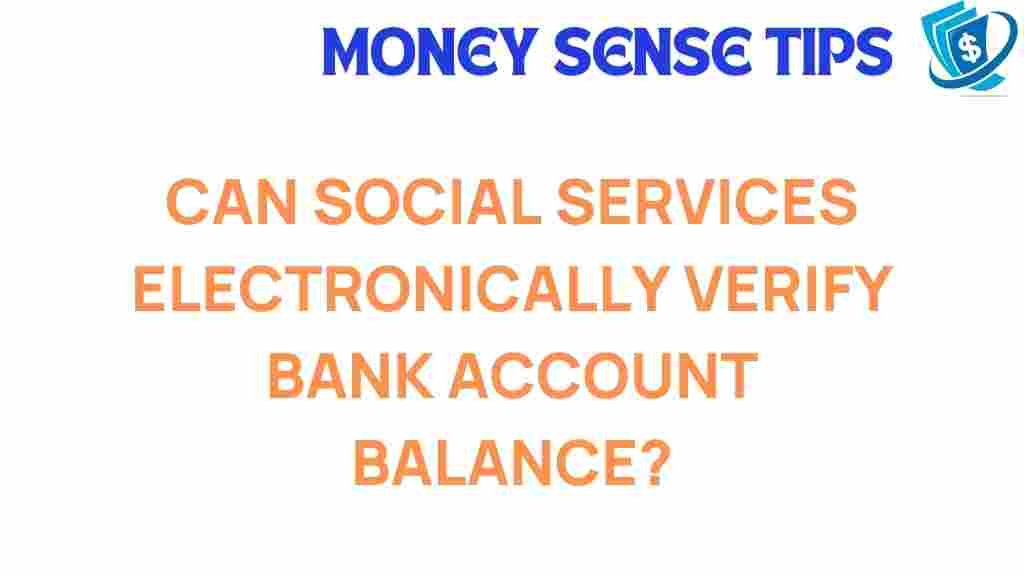Unveiling the Digital Dilemma: Can Social Services Verify Bank Accounts?
In the digital age, the intersection of social services and technology has transformed how financial assistance is distributed and managed. One of the pressing questions that arise in this context is whether social services can effectively verify bank accounts. This article delves into the intricacies of bank account verification within the realm of social services, exploring the implications of digital records, privacy concerns, and the role of technology in welfare.
Understanding the Need for Bank Account Verification
Bank account verification is a crucial process for social services that aim to provide financial assistance to individuals in need. This verification helps ensure that funds are distributed appropriately and to the right individuals. Here are some reasons why verifying bank accounts is essential:
- Preventing Fraud: Verification helps minimize fraudulent claims and ensures that only eligible individuals receive assistance.
- Streamlining Processes: Electronic verification methods can expedite the application and approval processes.
- Ensuring Compliance: Social services must comply with legal requirements regarding fund distribution, making verification a necessary step.
The Role of Technology in Welfare
With the increasing reliance on technology, social services are adopting electronic verification systems to manage applications and verify information. These systems utilize various digital records to confirm an applicant’s bank account details. The benefits of this technological shift include:
- Efficiency: Automated systems reduce the time and effort required for manual verification.
- Data Accuracy: Electronic records minimize human error and ensure that the information is up-to-date.
- Accessibility: Online platforms make it easier for applicants to provide necessary documentation.
The Process of Bank Account Verification by Social Services
To understand how social services can verify bank accounts, it’s essential to outline the typical steps involved in the verification process:
Step 1: Application Submission
Applicants seeking financial assistance must complete an application form, which typically includes personal information, income details, and bank account information.
Step 2: Document Provision
Applicants may be required to submit supporting documents, such as:
- Bank statements
- Proof of identity
- Income verification documents
Step 3: Electronic Verification Initiation
Once the application and documents are submitted, social services initiate the electronic verification process. This may involve:
- Accessing digital records from financial institutions
- Using third-party verification services
- Cross-referencing information with government databases
Step 4: Data Analysis
After gathering the necessary information, social services analyze the data to verify the authenticity of the bank account and the applicant’s eligibility for assistance.
Step 5: Approval or Denial
Based on the verification results, social services will either approve or deny the application. If denied, applicants usually receive a reason for the decision and may have the option to appeal.
Step 6: Fund Disbursement
Once approved, the funds are disbursed directly to the verified bank account, ensuring that the assistance reaches the intended recipient.
Privacy Concerns Surrounding Electronic Verification
While electronic bank account verification offers numerous benefits, it also raises significant privacy concerns. Stakeholders must balance the need for efficient service delivery with the protection of individuals’ sensitive information. Key concerns include:
- Data Security: Ensuring that personal and financial data is protected from unauthorized access and breaches.
- Informed Consent: Applicants should be aware of what information is being collected and how it will be used.
- Potential Misuse: There is a risk that data could be misused or mishandled, leading to identity theft or other fraudulent activities.
Mitigating Privacy Risks
To address these concerns, social services can implement several measures:
- Data Encryption: Encrypt sensitive information to protect it during transmission and storage.
- Regular Audits: Conduct audits of electronic systems to ensure compliance with privacy regulations.
- Training Staff: Educate staff about data protection best practices and the importance of safeguarding personal information.
Troubleshooting Common Issues in Bank Account Verification
Despite advancements in technology, applicants may still encounter issues during the bank account verification process. Here are some common problems and their solutions:
Issue 1: Incorrect Information Submitted
If an applicant submits incorrect bank account details, verification will fail. To resolve this:
- Double-check all entered information.
- Contact social services to correct any mistakes as soon as possible.
Issue 2: Delayed Verification
Sometimes, verification may take longer than expected due to system issues or high application volumes. Applicants can:
- Follow up with social services to check the status of their application.
- Be patient, as some delays are beyond the control of the service.
Issue 3: Privacy Concerns Raised by Applicants
If applicants express concerns about their privacy, social services should:
- Provide clear information about how data will be used and protected.
- Offer alternatives for verification if necessary.
Conclusion
The question of whether social services can verify bank accounts is complex, intertwining technology, privacy, and the essential goal of providing financial assistance to those in need. As electronic verification becomes more prevalent, understanding the processes, benefits, and challenges associated with it is crucial. By addressing privacy concerns and ensuring robust security measures, social services can leverage technology to improve service delivery while safeguarding the sensitive information of applicants.
For more information on how technology is reshaping social services, visit this resource on the future of welfare technology.
To explore more about privacy concerns and data protection practices, check this external article.
This article is in the category Services and created by MoneySenseTips Team
